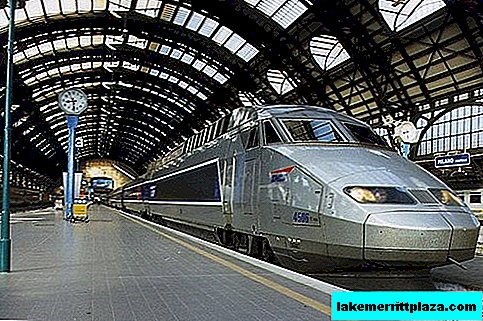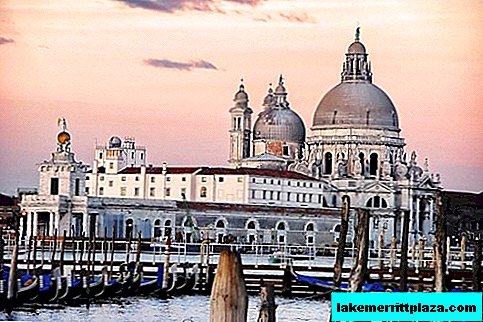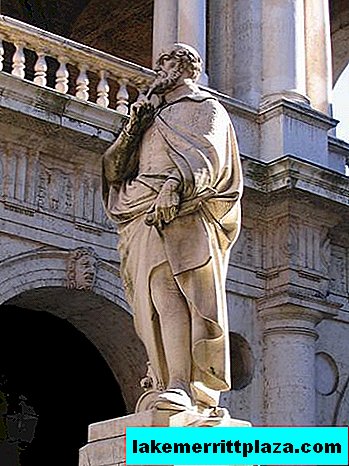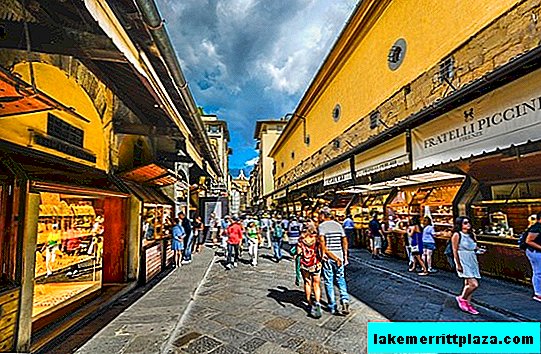The Sistine Chapel (Cappella Sistina) on the outside is an unremarkable 15th-century church building on the territory of modern Vatican. But, in the walls lined with sand-colored stone, the true pearls of the Renaissance era are enclosed - the works of Michelangelo (Michelangelo Buonarroti), Sandro Botticelli (Sandro Botticelli), Perugino (Perugino), Pinturicchio (Pinturicchio), Domenico Ghirlandaio (Domenico Ghirlandaio).
- We recommend to visit: excursion to museums and the chapel
- See also: What places in Rome should I visit with a guide?
- You will find it useful: how to get to the vatican
Story
The Sistine Chapel was built in 1475-1481 by order of the pontiff Sixt IV (Sisto IV) in honor of Mary's assumption in heaven.

The place of construction of the church was not chosen by chance. Earlier, in this place in Rome was the Great Chapel (Cappella Maggiore), which received the highest conclaves of the Catholic clergy. A grand reconstruction of the obsolete chapel was entrusted to the architect Baccio Pontelli and engineer Giovannino de 'Dolci.
The construction manager decided to keep the foundation and part of the lower tier of the previous construction. During the construction, the church received 3 floors, 2 of them were intended for the needs of the church, and the upper one was a gallery for guarding soldiers. The chapel itself also represents an example of fortification architecture: a rectangular building 20.7 m high, 40.9 m long, 13.4 m wide. Strong walls and a lack of frills were dictated by the turbulent atmosphere in fragmented Italy of the Middle Ages.
Murals

The Sistine Chapel is famous all over the world thanks to the frescoes that adorned its vault and walls in the 15-16 centuries. The general plan for painting the church was developed during the time of construction work. The building was divided into three horizontal tiers and was to be decorated from bottom to top. The lower tier had simple decorative paintings, the second tier was devoted to the events of the Old Testament and scenes from the life of Christ, reflected in the New Testament. The uppermost tier was to depict the pontiffs who received martyrdom.
Florentines
The beginning of the decoration of the Sistine Chapel was laid by Perugino, a master of the Umbrian school of painting. He depicted two paintings from the life of Christ and one from the Old Testament. By 1480, tense political relations between Pope Sixtus IV and the head of the Florentine Signoria Lorenzo de 'Medici the Magnificent (Lorenzo de' Medici) were somewhat warmer.

As a goodwill gesture, Medici sends the masters of the Florentine school: Botticelli, Ghirlandaio, Cosimo Rosselli, and the pontiff graciously allows them to settle in Rome and begin work in the Sistine Chapel.
The Florentines, with the support of Pinturicchio and Bartolomeo de Gatta, painted the walls of the new church. The plots of 10 frescoes were developed and approved down to the smallest detail by Sixtus IV himself. Particular attention was paid to the fact that compositions from the Old and New Testaments harmoniously complement each other. The artist managed to strengthen the impression of iconographic murals Piermatteo d'Amelia, who depicted on the arch of the temple in the starry sky.
Ceiling
The successor of Sixtus IV, his nephew Julius II (Ulius II), did not forget for a moment what the Sistine Chapel means to the Catholic Church.
Contribution of Michelangelo Buonarroti
In 1508, the pontiff invited Michelangelo Buonarroti to restore existing paintings and apply new ones.. The whole 4 years (from 1508 to 1512) took the famous master to decorate the vault.
It is noteworthy that at that time Michelangelo was considered an unsurpassed architect, while murals were new to him.
Contemporaries of the sculptor see the machinations of Buonarroti's competitor, Donato Bramante, as happened. Bramante was aware of his own mural candidate, Raffaello Santi.

Ceiling of the Sistine Chapel - was a real challenge for Michelangelo.
In addition to mastering the new art technique, the master had to solve organizational issues. How, for example, to establish forests under the very ceiling and at the same time not to interfere with church rites? "Flying forests", designed by the artist, were mounted on special pins to the walls of the church. At the same time, the artist and his apprentices were at the necessary height, and the clergy received freedom of movement.
There are various speculations regarding the operation of Buonarroti under the vault of the chapel. Some sources state that the master worked lying down, while paints and plaster abundantly showered on his face. Actually, Michelangelo worked while standinghaving room for maneuvers. However, hard work under the ceiling of the chapel damaged the health of the 33-year-old artist.

To top it all off, the wet layers of the plaster used to work with paints began to intensely become covered with fungus. The master and his assistants managed to derive a new formula of "intonaco" - a composition for impregnating plaster, which was resistant to moist Roman air.
Despite all the vicissitudes of fate, the ceiling of the Sistine Chapel was decorated with frescoes combined into a single iconographic cycle. Michelangelo depicted paintings illustrating nine scenes from Genesis. In the miniatures of the vault, one can consider “Separation of light from darkness”, “Sacrifice of Noah”, “Creation of Adam”, “The Fall”, “Expulsion from Paradise”.
The ceiling of the Sistine Chapel has three distinct semantic chains: the creation of the World, Adam and Eve, the burdens of mankind, devoid of Paradise.

Having examined each painting individually, one can trace the transformation of the painting of Buonarroti. Due to the high ceiling height, the artist refused small details and elaborate curls in favor of more concise and clear lines.
The plot of each fresco is concise and capacious, miniatures are enclosed in decorative frames made of travertine. The huge area of the ceiling could cause a depressing impression, “crush” the parishioners, if not for the little tricks of the master, who artificially divided the huge ceiling into 47 parts. Small paintings and geometric frames create an unprecedented depth and detail of the frescoes.

Pope Julius II strongly encouraged Michelangelo, in a hurry to hit the public with a masterpiece curiosity. The final frescoes were painted in a short time, however, the artist’s mastery allowed to maintain the deep impression made by the church ceiling. Also, the pontiff complained that the ceiling looks poor, due to the lack of gilding and azure. The master replied in reply that the saints themselves were not rich people.
The Last Judgment (Giudizio universale)
A quarter of a century later, the Sistine Chapel will again be at the disposal of Michelangelo. This time, an even more dramatic masterpiece will be created - a wall fresco depicting the Last Judgment.
Pope Clement VII in 1533 called Buonarroti to Rome and discussed the details of the design of the altar wall in the main chapel of the Vatican. The death of the pontiff pushed the start of work for 4 years. In 1536, Paul III (Paolo III) approved the plans of his predecessor regarding the Sistine Chapel and Michelangelo set to work.

The large-scale picture conceived by the pontiffs required difficult decisions. First, earlier frescoes painted on the wall behind the temple’s altar were sacrificed to the new creation. Secondly, a 40-cm brick visor was placed over the upper border of the painting, which would prevent dust from settling on the wall surface.
Having prepared sketches and purchased paints of the required quality, Michelangelo began work in the middle of 1536. Four years it took the artist to create a complete picture, during this time Buonarroti allowed only one of his assistants to brushes and paints, and then to create a heavenly background. All characters were written exclusively by the hand of the master.
During the restoration of the Sistine Chapel, art historians found that the whole mural is divided into fragments (squares made in one day), the number of which was 450 pieces!

The public saw the completed altar fresco "The Last Judgment" at the end of October 1541. There are records that Pope Paul III was so impressed by the picture on the chapel wall that he fell to his knees and indulged in fervent prayer. And there were good reasons for that! From the wall of the chapel, visitors were watched by heavenly angels soaring in the clouds, in the center of the picture were dramatically depicted Jesus and the Virgin Mary, surrounded by blessed ones. The lower tier is a picture of the End of Times: the messengers of the Apocalypse trumpet the Last Judgment, those who sinned descend to hell, and the righteous ascend to heaven.

This work of the 60-year-old Michelangelo was so brilliant that it excited the minds and hearts of everyone and everything.
Along with boundless admiration, she also generated discontent. Thus, Cardinal Carafa and the ceremonial master Biagio da Cesena expressed extreme indignation at the nakedness of the biblical persons. Paul III and Buonarroti ironically and steadfastly parried their opponents.
However, after 24 years, censorship nevertheless reached the "indecent" fresco and threw cover on the saints and the martyrs. Daniele da Volterra brought the fresco in a decent form, for which he received the nickname "Scribbler". As a student and fan of Michelangelo, the artist tried to minimize his interference.
Restoration

The ceiling of the Sistine Chapel, as well as wall murals are the subject of the Vatican's undoubted pride, as well as a masterpiece of fine art of the Renaissance. The pontificate cares about the safety of its property. So, the last restoration of the murals of the chapel took no less - 14 years, from 1980 to 1994!
Modern life

To date, the Sistine Chapel is still used for conclaves in which the pontiffs of the Vatican are elected. The rest of the time, the chapel is the Vatican Museum, which pilgrims and tourists seek to visit.
Male choir
In addition, the Sistine Chapel has a male choir, known as the "Papal Chapel" (Capella Papale).
The choir has a high status among Catholic singing groups. You can listen to the acapella performance of the high choir on major church holidays. The first composition of the papal chapel was organized under Sixtus IV. Since then, getting into the Sistine Choir has been a matter of great honor, and has brought great wealth. Since the 19th century, the full name of the band is Cappella musicale pontificia sistina.
Interesting facts and thatyna
Interesting facts and secrets regarding the Sistine Chapel and the personality of its author are interwoven into a fascinating story. After 5 centuries, one can only guess which of the existing legends is true, and which is a complete invention. In 2006, Konstantin Efetov published the book “The Shocking Secret of the Sistine Chapel,” in which he tried to make out the most fascinating mysteries of the temple. The book survived several successful reprints and was continued.

The focus of the study is Buonarroti, who agreed to leave the ranks of architects in order to master the skills of working with murals from scratch. The author asks why the medieval master was so reluctant to attract assistants, preferring to work alone. The idea was also voiced that young Michelangelo secretly studied the human anatomy and internal structure, in particular, he studied the structure of the brain well.
The artist did not fail to hint about this in the ceiling fresco "Creation of Adam". The creator, surrounded by angels, is depicted in a fringing of scarlet fabric, in its shape surprisingly resembling the human brain. The position of the hands of the creator, as well as the faces of the angels, repeat the main parts of the brain. Thus, Buonarroti declares that man was created not just by an abstract holy spirit, but is a product of a higher mind.

One and fierce critics of the work of Michelangelo Biaggio da Cesena was immortalized on the Last Judgment fresco. The artist, who almost completely painted the altar wall of the chapel, in response to the addiction to the excessive nudity of the characters, portrayed the champion of morality in the grotesque image of Minos, the king of the dungeons.
Unlike the shameless righteous, Minos is depicted as a serpent wrapped around his hips, which absorbs his manhood.
Another interesting fact - the master above all appreciated the beauty of nudity and preferred the male body. On all the frescoes, female characters are depicted with pronounced athletic figures.
Where is it, how to get there, tickets, opening hours

Address: Viale Vaticano, Cappella Sistina
- Metro line A to Ottaviano station
- tram No. 19, station Piazza del Risorgimento;
- by bus No. 49, entrance to the Vatican Museum near the bus stop; No. 32, 81, 982, station Piazza del Risorgimento; No. 492, 990, Via Leone IV / Via degli Scipion Station;
- rented car You can stop at a paid parking lot near museums;
- on Taxi you can get to Viale Vaticano, the entrance to the museum will be opposite.
Working hours: Monday to Saturday, from 9:00 to 18:00, you can buy a ticket from 9:00 to 16:00.
Individual excursions: only possible with an official guide. Sincerely recommend.
Tickets: Sistine Chapel is available on a single ticket to visit the Vatican Museums. A full ticket costs - 16 euros, preferential - 8 euros. To bypass the kilometer line to the ticket office, you can purchase a ticket on the Vatican’s ticket office on a step-by-step basis, paying an additional 4 euros for pre-order.
Visit Features: Photography and video are prohibited!
Official site: www.mv.vatican.va









